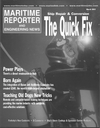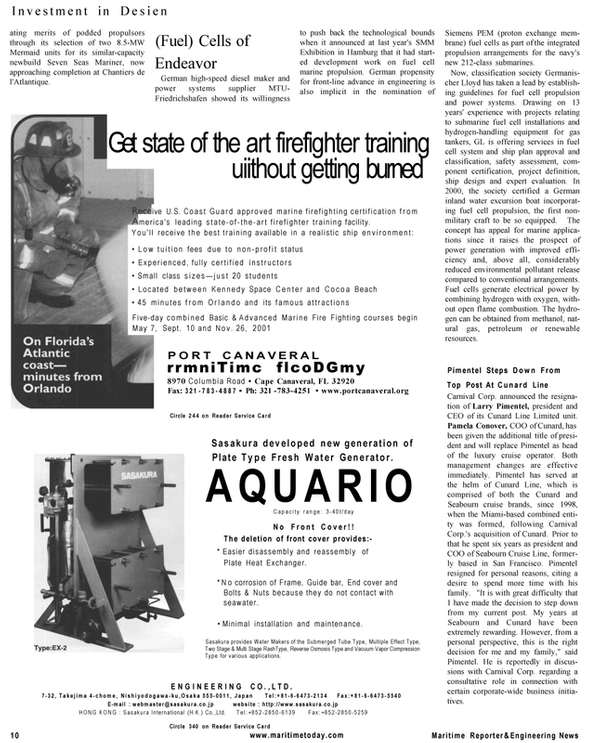
(Fuel) Cells of Endeavor
German high-speed diesel maker and power systems supplier MTUFriedrichshafen showed its willingness to push back the technological bounds when it announced at last year's SMM Exhibition in Hamburg that it had started development work on fuel cell marine propulsion. German propensity for front-line advance in engineering is also implicit in the nomination of Siemens PEM (proton exchange membrane) fuel cells as part of the integrated propulsion arrangements for the navy's new 212-class submarines.
Now, classification society Germanischer Lloyd has taken a lead by establishing guidelines for fuel cell propulsion and power systems. Drawing on 13 years' experience with projects relating to submarine fuel cell installations and hydrogen-handling equipment for gas tankers, GL is offering services in fuel cell system and ship plan approval and classification, safety assessment, component certification, project definition, ship design and expert evaluation. In 2000, the society certified a German inland water excursion boat incorporating fuel cell propulsion, the first nonmilitary craft to be so equipped. The concept has appeal for marine applications since it raises the prospect of power generation with improved efficiency and, above all, considerably reduced environmental pollutant release compared to conventional arrangements.
Fuel cells generate electrical power by combining hydrogen with oxygen, without open flame combustion. The hydrogen can be obtained from methanol, natural gas, petroleum or renewable resources.
Read (Fuel) Cells of Endeavor in Pdf, Flash or Html5 edition of March 2001 Maritime Reporter
Other stories from March 2001 issue
Content
- Diesel renaissance in Italy page: 8
- Dolphin Finds A Home page: 9
- (Fuel) Cells of Endeavor page: 10
- Maritime Transportation Is On Senate Subcommittee Agenda page: 11
- Aluminum Crewboat Built by Dubai Drydocks page: 12
- H o r i z o n Delivers Z - D r i v e Tug page: 14
- High Speed Ferry Set For Block Island page: 15
- Abu Dhabi Granted $ 5 0 M Naval Contract page: 15
- B2B for International Trade and Transport page: 16
- Seven Seas Voyager Will Boast Dolphin Podded Propellers page: 18
- Siemens To Supply Fuel Cell Technology page: 19
- IZAR: Hoisting More Than a New Image page: 20
- FORAN V50 Coming Soon page: 23
- Saving the Castor: Critical Issues Must Be Addressed page: 26
- Craft Bearing: On Solid Ground With Split Bearing Solution page: 28
- UMC Opens New Underwater Repair Facility in Portland, U.K. page: 29
- Bollinger Offers N e w Pitch To Ship Repair page: 30
- Titan Is Challenged In Persian Gulf page: 31
- Repair Pipe Leaks FAST W i t h STOP IT page: 32
- Suez Canal Authority O r d e r s Syncrolift page: 32
- Flender Werft Launches Floating Drydock page: 33
- Norshipco, MSC A n d M a e r s k Celebrate Renaming Of MV page: 34
- ASRY Grabs Hold Of UL/VLCC Market page: 35
- UPC Foam Filled Fenders: The Ultimate Protector page: 36
- Atlantic Dry Dock Takes On Tug And Gaming Market page: 37
- H y d r e x Team Performs U n d e r w a t e r W o r k O n S a i p em page: 38
- Raytheon Marine Purchased By Management Buyout Group page: 39
- GE Marine Starts Engineering For Eighth LHD page: 39
- U.S. Tank Barge Market Report page: 41
- Double Trouble? Double Trouble? page: 43
- Scottish Company To Revolutionize Coating Inspection page: 45
- Leading a Sea of Change page: 46
- The Practical Lifeboatman page: 48
- ICS Launches Video Conferencing Breakthrough page: 51
- Using Computer Based Training for STCW Basic Training page: 51
- Furuno Offers N e w GMDSS page: 52
- Austal USA Secures Candies Vessel Duo page: 54
- Samsung Delivers Excellence page: 58


